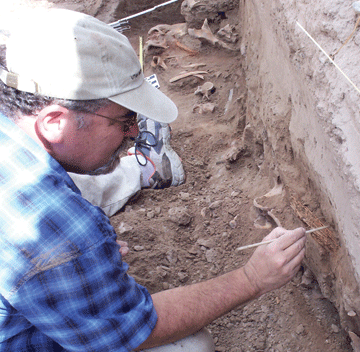|
- Native American remains reveal evidence of being executed
|

BURIAL SITE? • Ronald J. Rood, Forensics Antropologist with the Antiquities section of the Utah Division of State History carefully excavates skeletal remains found at a construction site in August 2006.
By Myrna Trauntvein
Times-News Correspondent
The remains of seven Native Americans found at the construction of a home of Kevin and Val Creps, just east of 131 East 300 North, according to historic evidence, were executed.
The skeletons unearthed during construction show several of the Native Americans were shot point-blank in the head.
“These Indians just happened to be in the wrong place at the wrong time,” said Ronald J. Rood, Forensics Anthropologist, Curriculum Director and Assistant State Archaeologist of the Antiquities Section of the Utah Division of State History.
Rood was responsible for retrieving the bones, scraps of clothing, copper ornaments and a lead bullet from inside a skull.
“We also found a piece of glass and a glass button on the first day,” said Rood.
The mass grave was found on Aug. 3, along the Old Hallow in north Nephi as the home site was being prepared for foundation work. Contractors stopped the excavation to call police and a medical examiner.
Settlers from Nephi, seeking revenge during a period of pitched violence in 1853, perpetrated the killings said Rood and fellow scientists who recently released their findings.
By one account, the Oct. 2, 1853, killings were in retaliation for the ambush a day before of four Manti farmers hauling wheat to Salt Lake City by oxen. That attack occurred at Fountain Green, about halfway between Manti and Nephi.
“There were a whole series of tit-for-tat killings,” Rood said.
However, the Nephi massacre of Native Americans occurred following a summer and fall of bloody conflict between settlers and raiding tribes. Various skirmishes fanned along the Wasatch front and through neighboring areas such as Juab and Sanpete Counties.
Rood said his findings refute an account by a Mormon militia regiment that the Indians approached Nephi refusing to drop their weapons and attacked first, hitting a settler with an arrow.
“A discovery like this allows the victims to tell their story,” Utah state archaeologist Kevin Jones said.
The victims, all males about 13 to 35 years old, are thought to be Goshute Indians, a peace-loving group who became casualties of the Walker War, a clash between Mormon settlers and Indian tribes under the leadership of Ute Chief Wakara.
Their bodies found in Nephi had been thrown into a shallow grave about 3 feet wide, Rood said.
“The bodies were heaped together,” said Rood.
Four of the victims were shot in the head. All of the victims showed defensive wounds. The hands of one Indian were tied behind his back. Several showed evidence of blunt-force trauma. One had a bullet hole through the femur.
The grave was covered by a cedar plank and several feet of sediment from flash floods over the years.
The event had been recorded in historical accounts as involving Isaac Morley, a leader of 225 settlers sent to Manti by Brigham Young, the second president of The Church of Jesus Christ of Latter-day Saints.
“We have the personal journals of two women who witnessed this event and described it as a heinous act of murder,” said Rood. “This is a great example of archaeology and history coming together.”
Martha Spence Heywood, a resident of Nephi and a polygamous wife of Territorial Marshal and leader of the Nephi colony, Joseph L. Heywood, said in her journal that the massacre at Uintah Springs incensed Isaac Morley so that he sought revenge on the Utes.
Heywood wrote: “This barbarous circumstance actuated our brethren, counseled by Father Morley of San Pete…and President Call of Filmore, to do quite as barbarous an act the following morning, being the Sabbath. Nine Indians coming into our Camp looking for protection and bread with us, because we promised it to them and without knowing they did the first evil act in that affair or any other, were shot down without one minute’s notice. I felt satisfied in my own mind that if Mr. Heywood had been here they would not have been dealt with so unhumanly. It cast considerable gloom over my mind.”
Rood teamed up with Derinna Kopp, a forensic anthropologist at the University of Utah.
Their investigation was the recent topic of a lecture at a conference of the Utah Statewide Archaeological Society at Utah Valley State College in Orem at the McKay Events Center.
Springville, Utah, historian D. Robert Carter set the stage for Rood with an overview of settler and Indian conflict in Utah Valley.
One of the first to be uncovered was a fairly young male skeleton.
“He was a younger person at death,” said Rood. “He had his wisdom teeth and had very good teeth.”
Cleve Winkle has been looking in Nephi for the remains of William Luke Sr. near the boundaries of the Nephi City Cemetery. That is another part of the story of the killings of the Native Americans found in Nephi.
Retribution for extermination of several Native Americans which occurred in Manti at the hands of settlers after several Native Americans had sought refuge there and the deaths of several Utes in another skirmish may have motivated a massacre near the head of Salt Creek Canyon on Oct. 1, 1853, when four Mormon settlers, Thomas Clark, James Nelson, William Reed and William Luke, were killed.
“When they (Morley and others) approached Uintah Springs, Utes had attacked the camp that morning. William Reed’s body lay stripped, scalped and disemboweled a short distance from the wagons,” said Winkle. The others were treated in like manner. Clark was not found until later so only three bodies were taken to Nephi for burial.
The Desert News later reported an account of a skirmish near Nephi as occurring the next day, Sunday, October 2, in which eight Indian men met their deaths.
|